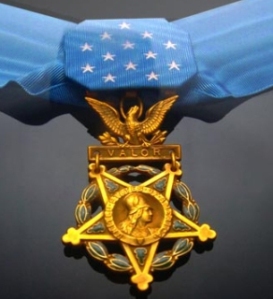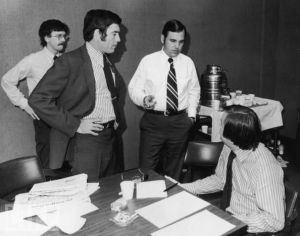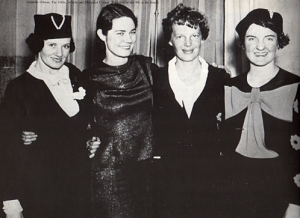The upcoming anniversary of the attack on Pearl Harbor on December 7, 1941 reminded me of an essay I wrote for PARADE in final month of 1979, as the decade of the Seventies was ending and we were still trying to recover from Vietnam.  The essay was based on my attendance at a gathering of recipients of the Medal of Honor and it revolved around the meaning of courage. I think its message holds just as true today, as we look back on a shocking, tragic event of American history that occurred sixty-eight years ago, when our country was suddenly catapulted into World War Two:
The essay was based on my attendance at a gathering of recipients of the Medal of Honor and it revolved around the meaning of courage. I think its message holds just as true today, as we look back on a shocking, tragic event of American history that occurred sixty-eight years ago, when our country was suddenly catapulted into World War Two:
An Essay by Hank Whittemore – PARADE – January 1980
Have Americans lost their courage? That question is often heard these days, along with the cynical observation that we’ve grown too soft to produce heroes.
Last November, I decided to attend the Congressional Medal of Honor Society’s biennial reunion in Tulsa, Oklahoma. Perhaps a good place to learn about courage would be among those who had demonstrated it in battle.
First I consulted the government’s list of the 3306 recipients of the Medal since it was first awarded during the Civil War. Under each name a citation tells what the man did to deserve his honor. You can open any page and find a story to match your worst nightmare. It is impossible to read these accounts of courage and not be overwhelmed.
Many of the Medals had been given posthumously. One soldier had “saved the lives of his men at the sacrifice of his life by throwing himself directly on the mine as it exploded.” That’s a typical description, not the exception. For those who remained alive, personal survival was an afterthought, an accident of fate.
“The Medal of Honor is the highest military award for bravery that can be given to any individual in the United States,” I read. “The deed of the person must be proved by incontestable evidence of at least two eyewitnesses; it must be so outstanding that it clearly distinguishes his gallantry from lesser forms of bravery; it must involve the risk of his life, and it must be the type of deed which, if he had not done it, would not subject him to any justified criticism.”
There are 275 Medal-holders still living among us: 10 from World War I, 144 from World War 11,38 from Korea and 83 from Vietnam. Of these, about 160 would be on hand at the Tulsa reunion.
At the meeting place in a downtown hotel, the “national media” were conspicuously absent. There were no hordes of reporters, no TV crews shoving their way into the reception hall. The local press was there, but most of the country would never learn that the event was taking place. Those who had exhibited the highest form of military courage while serving America were reaching out to each other in virtual anonymity.
Many of the men had brought their wives. They were dressed informally, with sports jackets and ties, and each man wore his Medal draped from its ribbon around his neck. They had name tags on their lapels. At first glance, you might have mistaken the group for a collection of ordinary businessmen. They greeted each other with handshakes, smiles, occasional embraces.
And soon you could feel that there was much more in the room, a more powerful emotion beneath the surface. Wandering around as a stranger, I saw two men who had each lost an arm. I saw a man who had lost one of his legs. Others were limping. Several had scars from burns. Nearly all, I learned, were carrying wounds of one kind or another.
At some point it struck me. The world may forget these men and what they have done, but as long as any are still alive, they will not forget each other – because they know what courage is; because each man knows that the others understand what he went through; because of a common bond, transcending generations and races and all other differences; because they share a secret that is almost impossible for them to express to anyone else.
If I could learn that secret, I thought, maybe then I would have answers for those who worry about our courage. And so I joined the Medal-holders as they took bus tours, attended banquets, listened to speeches. I spoke to dozens of them, in small groups and individually – trying to learn the secret.
Each man openly admitted that he had been afraid. His courage had required an awareness of danger, not blindness to what was at stake. His act was not rash, but deliberate. What counted was how he had controlled or handled his fear. He had “respected the situation” and then risen to it.
But along with fear, I noticed, there had been anger. A man had gotten mad as hell at the course of events and said, in effect, “I won’t submit to that! I won’t let it happen! Maybe this is the way things are supposed to be, but I’m going to change it!” And so, rather than give in to torture, he had slit his wrists. Or jumped on top of a deadly grenade. Or stood up and fired at the enemy in the face of almost certain death. And by his action, he had made all the difference.
Underneath the fear and the anger, however, there had been a dedication to others. This sort of courage – perhaps courage itself – is not selfish. It regards comrades’ lives as more valuable than one’s own. It means being willing to crawl back into a flaming helicopter to save the pilot, diving down to a submarine to rescue those who are trapped; instead of fleeing for safety, racing out to treat the wounded and helpless and dragging them away from the bullets.
Courage, I found, is not the result of a contest. You don’t “win” the Medal of Honor. You have a certain amount of training and experience, but then comes an event that calls for spontaneous action. You either respond in a certain way or you don’t. You cannot predict, ever, what you will do. Not a single Medal- holder was aware, beforehand, that he really had the “guts” to be a hero.
And that is part of the secret: These men, holders of the highest award for courage we’ve got, are just like the rest of us. Among them at the reunion were a college professor, a furrier, a police chief, a real estate salesman. They had come from steel mills, farms, assembly lines and executive suites.
The important fact was not their differences from us, but their sameness. As a group, they represent the diversity, and the ordinariness, of the whole nation. They reflect the actual and potential courage that exists throughout American life. They are a national treasure, symbolizing our capacity for valor. By taking a good look at them, it is possible to see ourselves.
For each of the Medal-holders there had been no script to follow. Before they acted, they had been just as “normal” as you or I. If a situation calling for courage arises, will we respond as heroes or will we shrink away to save ourselves?
There is no certain answer. Which, I believe, is also part of the secret. Heroism is an individual matter that cannot be “seen” in the absence of a test. You cannot find it by looking at your neighbors or in a mirror. It is something that happens at the moment. Until then, no one has the right to judge who among us does or does not have courage.
These lessons, I believe, apply to courage in all its forms, not just military. For everyone, crises arise throughout life that test courage – in our jobs, in the family, in relationships with friends and with strangers.
What saddened me at the Medal of Honor reunion was the feeling on the part of the recipients that their courage has so little meaning for the rest of us. “The Medal has a different significance these days,” a Vietnam veteran said. “If I had received it during World War II, I’d be treated differently. I came home as a soldier in scorn, so to speak. Today, most kids don’t even know that the Medal exists, much less what it means.”
Isn’t it time we distinguished between the traumatic Vietnam experience and those who fought in that controversial conflict? Isn’t it time we re-learned the Medal’s meaning, for ourselves and future generations? Surely another war isn’t necessary in order to know that we haven’t lost our courage.
The men who gathered in Tulsa have put away their Medals until the next reunion. They go about their lives with that secret they share. They know what courage is – and so should we.







